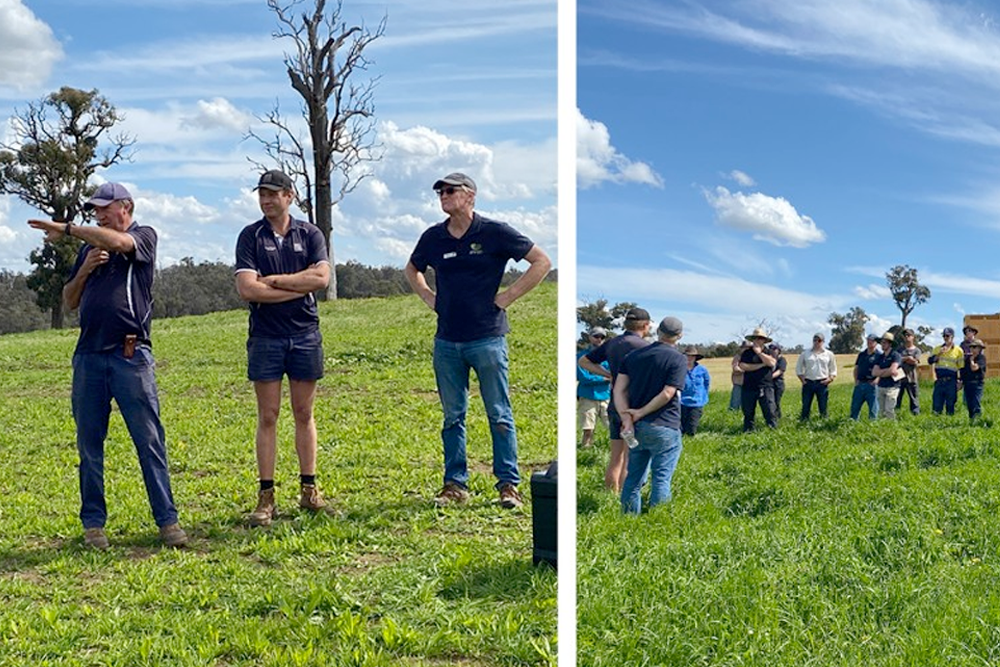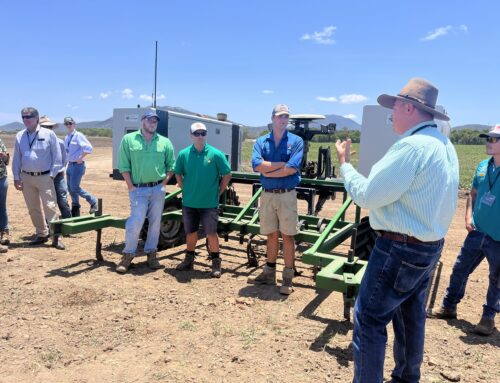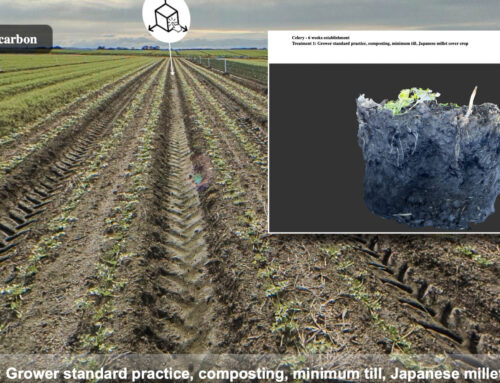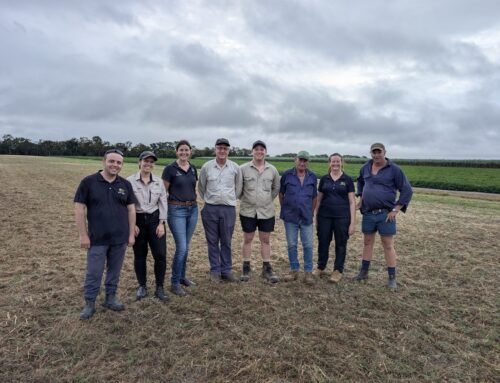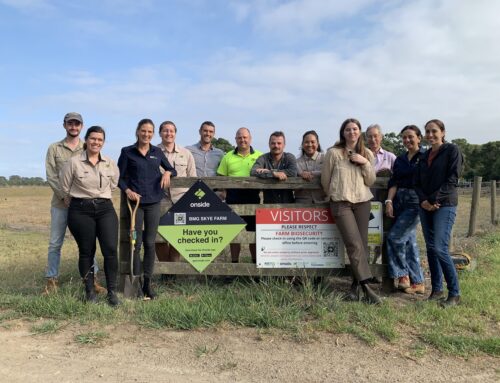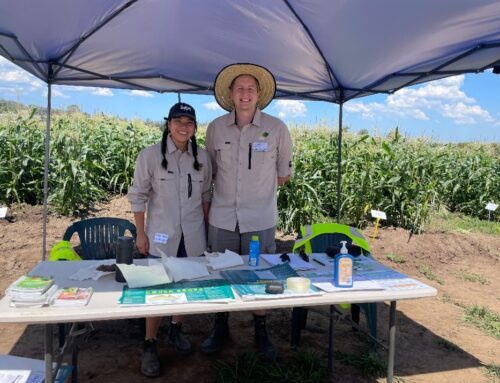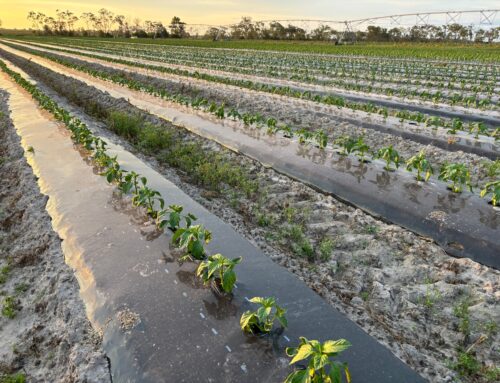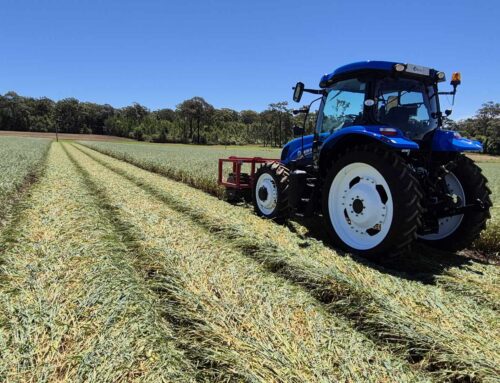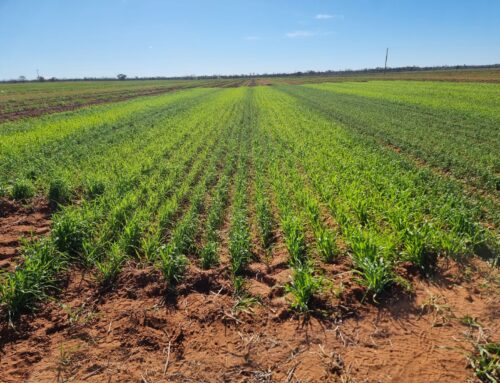During a visit to Western Australia in September, the Soil Wealth ICP team joined PotatoLink for a field walk in Manjimup to discuss how cover crops can be used to improve soil health and crop quality.
The event had an impressive turnout with almost 60 growers and industry members.
Attendees observed the use of cover cropping and strip-tillage in two vegetable farming systems and cropping rotations at Manjimup with local growers, Jake Ryan and Andrew Falcinella.
Soil Wealth ICP team member Dr Kelvin Montagu led the discussion on cover cropping, biofumigation, strip-tillage and soil health, highlighting what growers should consider before adopting these practices and how to achieve the best results.
A tale of two farmers
Jake Ryan grows vegetables alongside broadacre crops, sheep and cattle and produces eggs. He has used cover cropping and reduced tillage on his farm for several years.
His rotation is four years pasture/cover crop (one year perennial species and three years annual species) and one year of vegetables. The annual species cover crop is a mixture of ryegrass, clovers (crimson clover, arrow clover, subterranean clover, balansa clover), medic and cereals (oats, ryecorn, barley).
Jake believes nutrition management is the key to his success. He understands the nutritional needs the cover crop pastures, and applies fertiliser appropriately to ensure the crop is healthy. This has led to postive outcomes in livestock health and the success of his vegetable crops.
Andrew Falcinella is a potato grower who also has avocado orchards, cattle, and cuts hay and silage on his property. He is determined to improve his soil health by implementing changes to his farming system.
In particular, he has used biofumigant cover crops to manage and reduce soil-borne diseases in his potato crop.
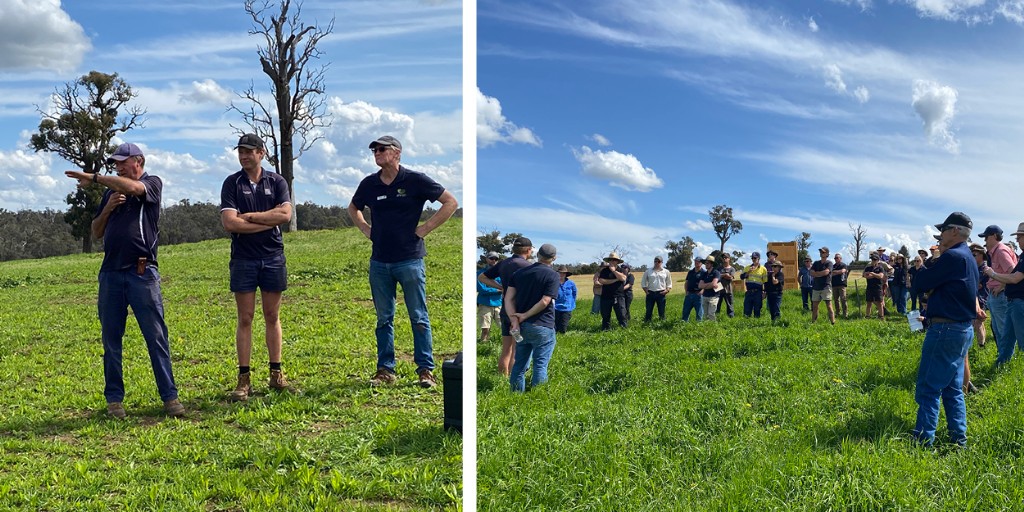
L-R: Gary Ryan, Jake Ryan and Dr Kelvin Montagu talking to attendees about changes in practices on-farm over the years; and Jake showing attendees a pasture cover crop containing a mix of annual species.
Cover cropping insights
Cover cropping specialist Dr Kelvin Montagu said it was important for growers to have a clear understanding of what they want a cover crop to achieve on their farm, as the species and timing of planting and termination will be different for every grower.
Some considerations that will influence cover crop decisions include:
- Whole farming system (what crops are being grown and rotations)
- Window of time available to plant, grow and terminate a cover crop
- Machinery available for planting and termination
- Labour and time available to manage the cover crop
- Soil-borne diseases present at the site (choose non-hosts if this is the case)
- Soil type
- Location and topography
- Tolerance of residues in cash crop.
“Cover crops need some effort to get the best results,” Kelvin explained. “If the window is short between cash crops, consider growing fewer species in the cover crop.”
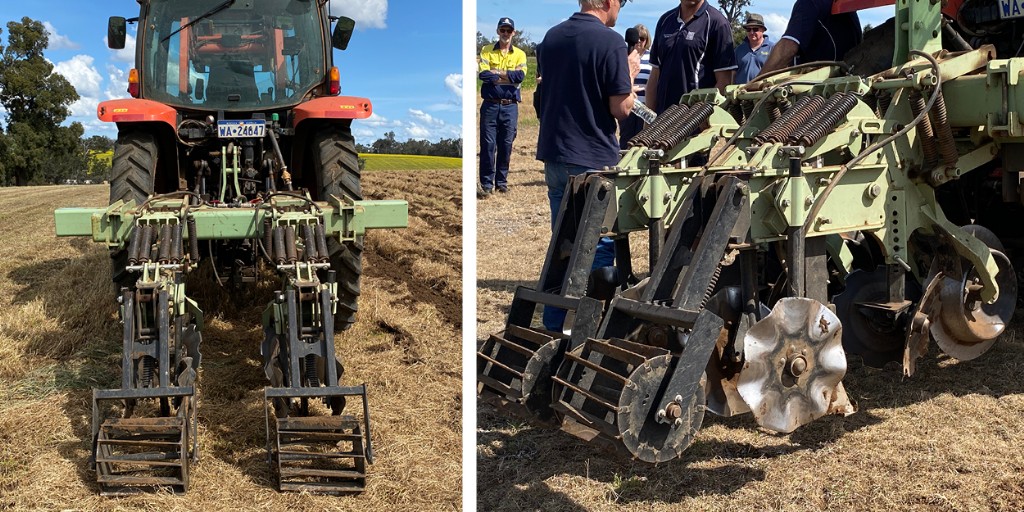
L-R: Strip-till machine.
Strip-tillage insights
Jake largely had a positive experience in transitioning from conventional cultivation to strip-tillage, reducing the time spent cultivating the soil, saving fuel and reducing the number of passes from five to one.
“The strip-tiller paid itself off within the first year. We saved 10,000L of fuel in the first year of using it,” Jake said.
“Beyond direct input costs, cultivating through strip-tillage has improved soil health, soil structure, soil biology and reduced erosion. It has created a nicer environment for picking produce in wet conditions as the soil structure holds and it’s less muddy. In some cases, this has enabled the team to plant and harvest sooner than others in the region.”
However, Jake’s cover cropping system grows for more than six months before termination and strip-till, allowing the plants enough time to establish and develop advanced root systems. With this, the strip-tiller can struggle to cut through the biomass, leaving the roots and leaf biomass holding together like a mat (particularly when ryegrass is in the cover crop mix). This can limit effectiveness of soil preparation, which can disrupt the transplanting process, ultimately leading to differences in crop uniformity.
During the field walk at Jake’s property, attendees observed an area under low biomass after a cover crop was terminated using a herbicide. Strip-tillage was successfully used in this area to prepare the soil for transplanting vegetable seedlings and attendees witnessed the strip-till machine in action, noting that it operated smoothly and returned good results in only one pass.
In another area of the farm with higher biomass from herbicide-terminated cover crops, the strip-tillage implement struggled to cut through the biomass and cultivate effectively in one pass. This delivered results with varying success, which had some impact to seedling transplants.
“The biomass of a cover crop needs to be managed carefully as too much biomass can limit or disrupt the success of strip-tillage,” Jake said.
“It’s important to plan ahead and be organised to avoid too much biomass. Consider the timing of planting the cover crop, its growing period, timing of termination before preparing for vegetables and choice of cover crop species.”
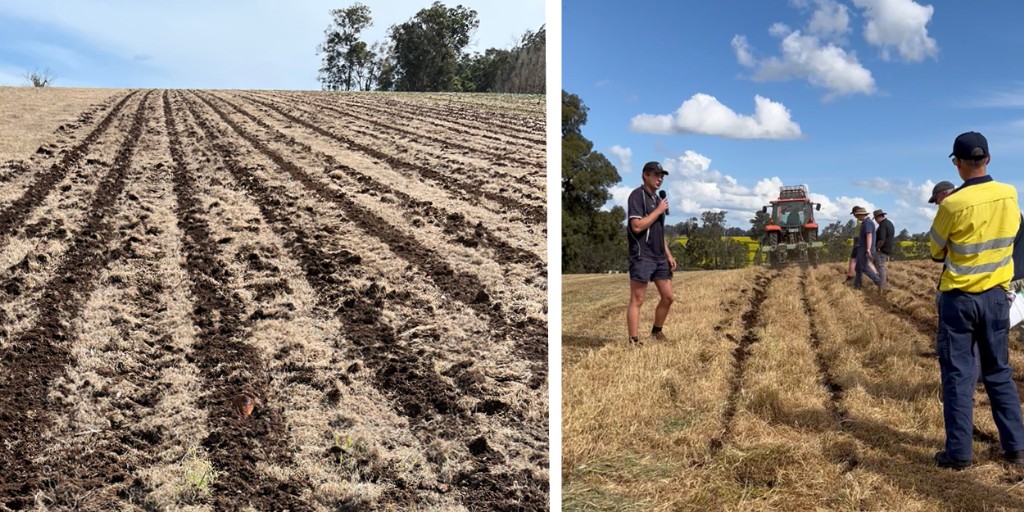
L-R: Successful strip-tillage demonstrated to attendees; and a high biomass cover crop cultivated using strip-tillage demonstrates the challenges when there is too much biomass.
Biofumigation insights
Biofumigants are a unique type of cover crop that produce compounds with suppression effects on soil-borne pathogens, pests and weeds.
At Andrew’s farm, attendees observed a biofumigant cover crop containing Caliente Rojo (Indian mustard Brassica juncea) and Nemat (rocket Eruca sativa) being mulched and incorporated into the soil.
Andrew and Kelvin explained that ongoing management of biofumigants is required to get the best results and strong growth. For Andrew, the timing of termination of biofumigants is a key consideration at his farm as the amount of biomass the crop produces can influence the effectiveness of the biofumigant. It is also important to manage biofumigant residues ahead of planting a potato crop.
Biofumigant species can help to manage certain diseases and avoid hosting other destructive pests and diseases. David Anderson from Beta Spuds also discussed the use of the PREDICTA Pt testing service to identify which soil-borne pathogens pose a risk at the site prior to planting a crop.
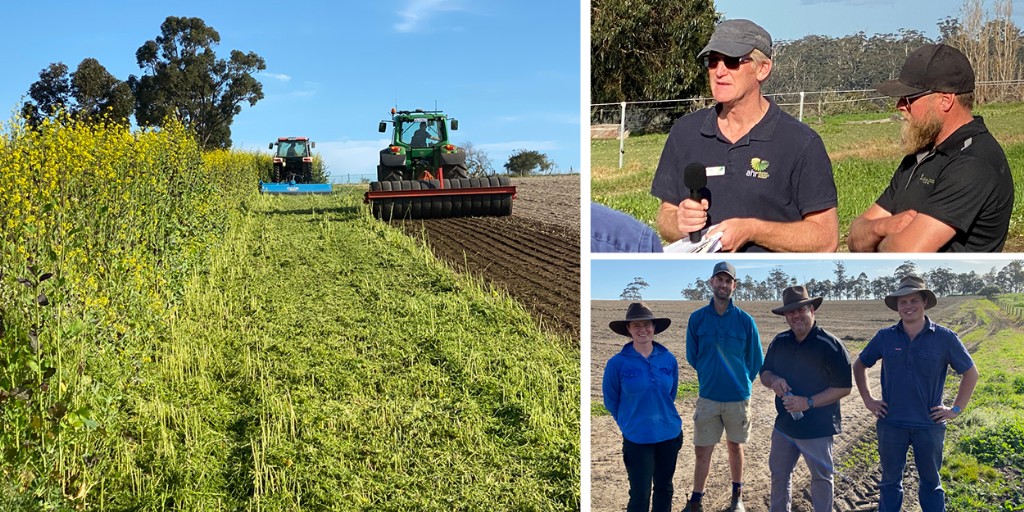
Clockwise from left: Demonstration of mulching and incorporation of biofumigant cover crop; Dr Kelvin Montagu with grower Andrew Falcinella; and attendees Jennifer Riseley, Mitchell East, Bevan Eatts and Ewan Eatts.
More information
The Soil Wealth ICP team would like to thank Jake Ryan and Andrew Falcinella for hosting the field walk on their properties as well as Dr Kelvin Montagu, David Anderson, Mark Warmington and Rachel Lancaster for their support.
Below is a list of helpful resources on the topics discussed in this article.
Cover Crops
- Soil Wealth Webinar: Rediscovering cover crops with Kelvin Montagu
- PotatoLink Webinar: Cover crops for fresh market and processing potatoes in Australia
- Soil Wealth Factsheet: What is a cover crop worth? Cover crops in Australian vegetable systems
- Soil Wealth Factsheet: Managing cover crop residues in vegetable production
- Poster: Cover crops for Australian vegetable growers
- Poster: Cover crop termination guide
- Poster: Cover crop herbicide guide
Strip-till
- Soil Wealth Case Study: Cover crop + strip-till combination
- Soil Wealth Podcast: Saving time and money with strip-till in WA
- Webinar: Strip-tillage for vegetables and potatoes with Steve Peterson (USA) and Ben Pogiolli
- Video: Strip-till in Tasmania; A reduced till farming system
- Video: Lyndon Orpwood discusses the benefits of strip-tillage to Simplot Australia
- Video: Strip-till for corn production – Reducing erosion, building robust soils
- Video: Strip-tillage in the field – Jeff McSpedden, NSW case study
Biofumigation
- Fact sheet: biofumigation
- Guide to Brassica Biofumigant cover crops
- Webinar: Biofumigation Cover Crops PART 1: What variety and when?
- Webinar: Biofumigation Cover Crops PART 2 Pest & diseases & impact on soil-borne diseases
- Soil Wealth Webinar: Biofumigation cover crops in vegetable production with Julie Finnigan

